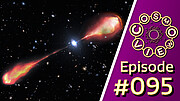Astronomers used Chandra and the Karl G. Jansky Very Large Array (VLA) to study this black hole and its jet at a period they call “cosmic noon,” which occurred about three billion years after the universe began. During this time most galaxies and supermassive black holes were growing faster than at any other time during the history of the universe.
The main graphic is an artist’s illustration showing material in a disk that is falling towards a supermassive black hole. A jet is blasting away from the black hole towards the upper right, as Chandra detected in the new study. The black hole is located 11.6 billion light-years from Earth when the cosmic microwave background (CMB), the leftover glow from the big bang, was much denser than it is now. As the electrons in the jets fly away from the black hole, they move through the sea of CMB radiation and collide with microwave photons. These collisions boost the energy of the photons up into the X-ray band (purple and white), allowing them to be detected by Chandra even at this great distance, which is shown in the inset.
Researchers, in fact, identified and then confirmed the existence of two different black holes with jets over 300,000 light-years long. The two black holes are 11.6 billion and 11.7 billion light-years away from Earth, respectively. Particles in one jet are moving at between 95% and 99% of the speed of light (called J1405+0415) and in the other at between 92% and 98% of the speed of light (J1610+1811). The jet from J1610+1811 is remarkably powerful, carrying roughly half as much energy as the intense light from hot gas orbiting the black hole.
The team was able to detect these jets despite their great distances and small separation from the bright, growing supermassive black holes — known as “quasars” — because of Chandra’s sharp X-ray vision, and because the CMB was much denser then than it is now, enhancing the energy boost described above.
When quasar jets approach the speed of light, Einstein’s theory of special relativity creates a dramatic brightening effect. Jets aimed toward Earth appear much brighter than those pointed away. The same brightness astronomers observe can come from vastly different combinations of speed and viewing angle. A jet racing at near-light speed but angled away from us can appear just as bright as a slower jet pointed directly at Earth.
The researchers developed a novel statistical method that finally cracked this challenge of separating effects of speed and of viewing angle. Their approach recognizes a fundamental bias: astronomers are more likely to discover jets pointed toward Earth simply because relativistic effects make them appear brightest. They incorporated this bias using a modified probability distribution, which accounts for how jets oriented at different angles are detected in surveys. Their method works by first using the physics of how jet particles scatter the CMB to determine the relationship between jet speed and viewing angle. Then, instead of assuming all angles are equally likely, they apply the relativistic selection effect: jets beamed toward us (smaller angles) are overrepresented in our catalogs. By running ten thousand simulations that match this biased distribution to their physical model, they could finally determine the most probable viewing angles: about 9 degrees for J1405+0415 and 11 degrees for J1610+1811.
These results were presented by Jaya Maithil (Center for Astrophysics | Harvard & Smithsonian) at the 246th meeting of the American Astronomical Society in Anchorage, AK, and are also being published in The Astrophysical Journal. A preprint is available here. NASA’s Marshall Space Flight Center in Huntsville, Alabama, manages the Chandra program. The Smithsonian Astrophysical Observatory’s Chandra X-ray Center controls science operations from Cambridge, Massachusetts, and flight operations from Burlington, Massachusetts.
Visual Description
This release is supported by an artist’s illustration of a jet blasting away from a supermassive black hole.
Shooting out of the black hole are two streaky beams of silver and pale violet. One bright beam shoots up toward our upper right, and a second somewhat dimmer beam shoots in the opposite direction, down toward our lower left. These beams are encircled by long, fine, corkscrewing lines that resemble stretched springs.
This black hole is located 11.6 billion light-years from Earth, much earlier in the history of the universe. Near this black hole, the leftover glow from the big bang, known as the cosmic microwave background or CMB, is much denser than it is now. As the electrons in the jets blast away from the black hole, they move through the sea of CMB radiation. The electrons boost the energies of the CMB light into the X-ray band, allowing the jets to be detected by Chandra, even at this great distance.
Inset at our upper righthand corner is an X-ray image depicting this interaction. Here, a bright white circle is ringed with a band of glowing purple energy. The jet is the faint purple line shooting off that ring, aimed toward our upper right, with a blob of purple energy at its tip
News Media Contact
Megan Watzke
Chandra X-ray Center
Cambridge, Mass.
617-496-7998
mwatzke@cfa.harvard.edu
Lane Figueroa
Marshall Space Flight Center, Huntsville, Alabama
256-544-0034
lane.e.figueroa@nasa.gov





















